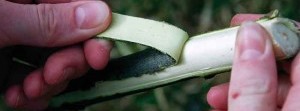
Eurasian Collared-Doves
The legend goes like this: In the 1970s an exotic pet breeder transported fifty Eurasian collared-doves from the Netherlands to the Bahamas. His pet store was broken into and during the robbery the birds escaped. The birds nested, bred, and spread to neighbouring islands and by the 1980’s arrived in Florida. They made themselves at home and proceeded to colonize North America. In the last ten years, they have arrived in northern BC.
“These birds are incredibly good at adapting to urban environments,” says Dr. Ken Otter, UNBC biology professor and president of the Society of Canadian Ornithologists. “They are totally on the rise. They are all over Prince George now, whereas five years ago you could only find them around Cottonwood Park and in low numbers.”
Larger than a robin and smaller than a crow, collared-doves are pigeon-like in appearance with a large body, small head and a distinctive crescent-shaped black band at the nape of the neck. They sing a repetitive and incessant cooing song, a rhythmically mournful koo-KOO-kook.
“They start cooing at about five in the morning,” says Vanderhoof resident Brian Frenkel. “We had two living in a spruce tree right beside our bedroom window. I made sure the first day we heard them, before they nested, I shook the tree and they left and didn’t come back. But they’re in my neighbours’ trees now,” he adds with a chuckle.
An “urban invader species,” these birds prefer residential areas and often nest near houses and other developed areas where food is easily available. According to The Cornell Lab of Ornithology, “bird feeders and trees planted in urban and suburban areas are cited as two of the main factors in the species’ colonization of the continent.”
These invasive birds are protected by an odd bit of government red tape. Currently there is no open hunting season in BC for the Eurasian collared-dove because it’s a species protected under the Federal Migratory Birds Convention Act.
“Who considers them migratory?” asks Kamloops resident Russell Mount. “They set up shop and stay and multiply six times a year. I had to cut down every tree in our yard to get rid of the awful, noisy, pests. They never once went anywhere for winter.”
The collared-dove is one of three species protected under the Migratory Birds Convention Act that doesn’t actually meet the criteria.
In BC other invasive bird species including the European starling and house sparrow are managed under Schedule C of the British Columbia Wildlife Act, which removes protection for species considered a nuisance and enables year-round public control. However, the listing of the collared-dove under the federal act precludes its listing in Schedule C. According to the Canadian Wildlife Service, “the province of British Columbia has repeatedly asked for tools to allow management programs for Eurasian collared-doves.”
This year, a first step is being made in that direction. A proposed change to the 2018-19 BC hunting regulations would open a hunting season for Eurasian collared-doves in the Thompson, Kootenay and Okanagan. The change would “assist provincial programs aimed at controlling invasive species,” according to the Government of Canada website.
But will people hunt them? It’s one thing to declare open season on an invasive species; it’s another to actually hunt and eat them.
Consensus among hunters who joined a discussion on bchunting.com is, “Damn right I would hunt and eat them. They are tasty.”
One hunter goes on to say, “I have eaten lots of mourning doves and they are excellent table fare. Can’t imagine the collared-dove would be different, they are almost identical.”
With the number of collared-doves increasing in northern BC, can we expect an open season in this region as well? Would it make sense to open a season now to get ahead of the rising population?
“I would be a little bit cautious about that,” says Otter. “You would think that given the numbers across North America it wouldn’t have much of an impact, but that same logic was applied to passenger pigeons and they were hunted to extinction by the early part of the 1900s.” Additionally, Otter says, “There’s no strong evidence that expansion is causing major detrimental effects.”
In fact, a study by the Cornell Lab of Ornithology that looked at populations in Florida over a nine-year period found no evidence of negative impact on native bird species. Contrary to what researches expected to find, the number of other dove species actually increased in areas where the collared-doves were found.
The study does offer this word of caution: the birds were found in areas with a high abundance of food. In areas where food is scarce there could be increased competition with native species.
The abundance of food is a result of the collared-doves strong preference for residential areas and that could prove to be the limiting factor to hunting these birds. How do you have an open hunt on a bird that prefers residential areas? “The problem that most people will tell is that their numbers are increasing within community limits,” says District of Vanderhoof Councillor Brian Frenkel. “There’s a lot of invasive species all around the world and as a council we would need a lot more information before the District of Vanderhoof would entertain a hunt.”
One thing is certain, these birds are incredibly adept at adapting to varied environments and we will continue to see and hear collared-doves in increasing numbers in northern BC.
If you would like to help monitor Eurasian collared-doves in your backyard, join the Citizen Science: Project NestWatch at birdscanada.org. Crucial information on the spread of this species is collected through this nest monitoring program.
— Britta Boudreau



